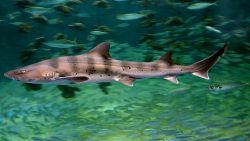select your film:


Banded Houndsharks are relatively widespread and common throughout its distribution from southern Russia to China in the Northwest Pacific Ocean. They mostly frequent sandy flats, beds of seaweed and eelgrass close to shore at depths of 150 m.
Biology and Behaviour
Banded houndsharks feed on invertebrates and can grow to a maximum length of 150 cm. Off the coast of Japan, male Banded hound sharks mature between 93 to 103 cm at five to six years old. While females mature between 106 to 117 cm at six to seven years. They can reach 150 cm long.
They have a short, rounded snout with widely spaced nostrils. Their horizontally oval eyes are placed high on their head which, like many other sharks, have nictitating membranes with ridges underneath. They have five pairs of gill slits.
Banded houndsharks mostly narrow fins. They pectoral fins are broad and triangular, and the trailing margin of the first dorsal fin is almost vertical. They are grey above and lighter below. Young sharks will have darker saddles and dots, but as they age, the spots and saddles will fade.
Banded houndsharks are nocturnal and mainly solitary. They prey on crustaceans such as shrimp and crabs, cephalopods such as octopus and spoons worms and bottom-living bony fishes.
Reproduction and Lifespan
Females are ovoviviparous. The eggs are carried within the mother until the young sharks are ready to hatch. Female banded sharks can have as many as 42 pups after a 9 to 12-month long gestation period. The size at birth for pups is 18 to 20 cm.
Male banded houndsharks live to about 15 years, while females live to 18 years.
Conservation and Tourism
The IUCN lists Banded houndsharks as least concern.
They are commonly fish off the coast of Japan, possibly in Korea and Northern China as well, in gillnets and set nets. Banded hound sharks are not targeted, but similar to many sharks they are caught as bycatch and then sometimes used for their meat.
Banded houndsharks can be seen in aquariums in China and Japan. There are no conservation measures in place for banded houndsharks.
Do you have images or videos of Banded Houndsharks?
Submit them to [email protected].
